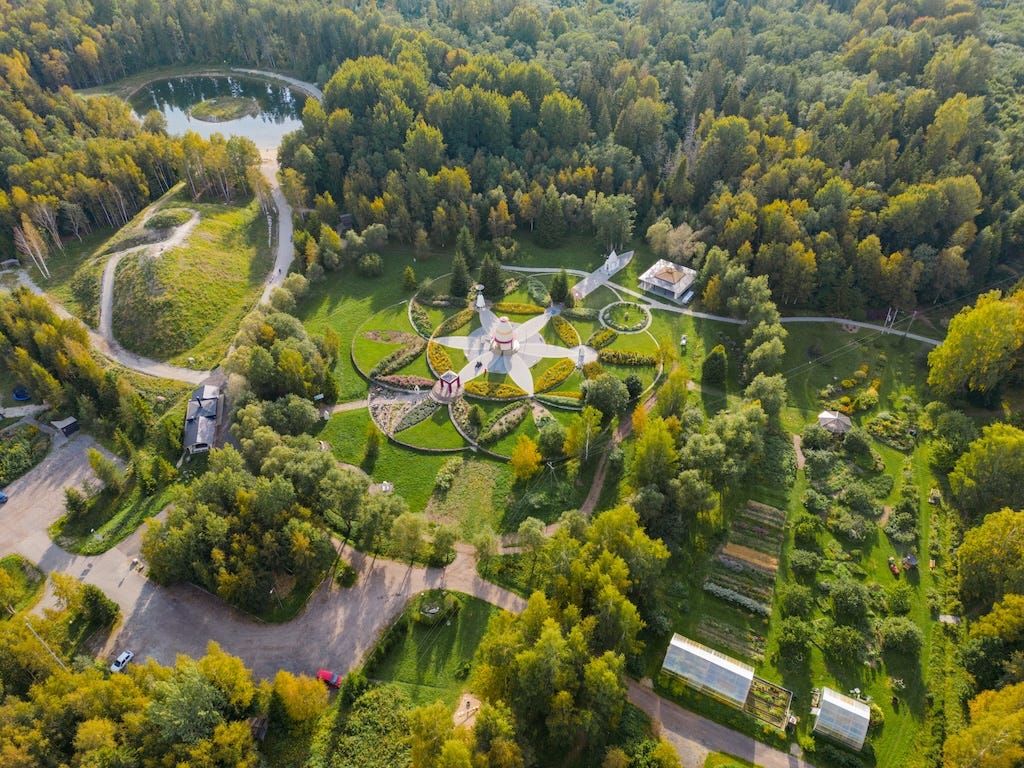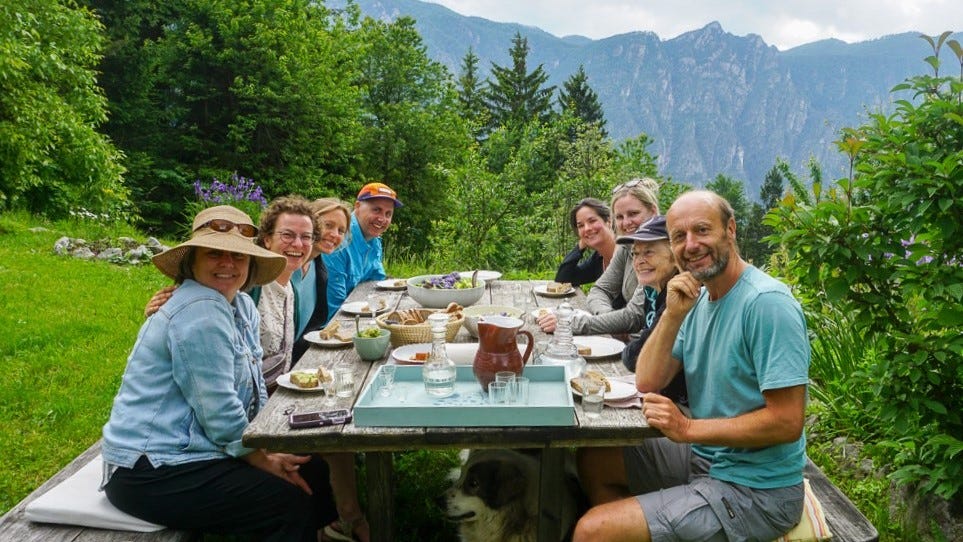Top 6 Trends for Regenerative Villages in 2025
What you can expect in the field of regenerative land (re)development
Another year is upon us. I can’t help but feel this as my primary sentiment:
But of course, the world doesn’t stop, and the regenerative village movement is becoming more and more mainstream. Here’s my take on trends I’ve been closely observing as a village researcher and designer in this field.
2025 Overview
It’s just a given that regenerative villages will continue to pop up around the world, although there is no indication that any of these ventures will be risky or exceedingly innovative this year as we prepare for an uncertain future.
There may be a few standout projects that, thanks to a lucky combination of funding, a strong team, and a highly professional approach, will produce a regenerative village project worth noting.
As the world stage becomes more absurd and more fantastical, the challenges that regenerative villages already face will become more apparent in 2025. This includes funding, accessibility, and equity within projects.
Communities will be called to step up their game — combining traditional wisdom with modern innovation to address climate challenges, economic instability, and even class wars.
Whether you’re dreaming of starting your own village, investing in one, or simply curious about where this movement is headed, the following five trends paint a picture of what I dare say we can expect for regenerative villages this year:
1. A Shift Away From Hospitality-Driven Business Models
Let’s be honest—how many times have you heard someone say, “I’m starting a retreat center”?
It’s a beautiful idea, but the market is oversaturated. Eco-retreats have been popping up in every corner of the globe, with nothing particularly unique to distinguish them from each other.
Add that to the global economic instability, and it becomes clear that relying on short-term stays as a primary income source in village building is increasingly risky and encourages unsustainable travel.
Take Earthaven Ecovillage, for example. Their retreat-based revenue model faced major disruptions when Hurricane Helene caused road closures this year, cutting off access to their site. Villagers lost income from these closures and had to crowdfund 10k to recuperate.
Events like this highlight the vulnerability of hospitality-focused communities to natural disasters and economic downturns.
Instead, many regenerative villages are exploring models that offer mid-term stays, targeting slow travelers and digital nomads. They are trading the higher ticket, short-term guest for the more stable and less-turnover long-term guest.
These residencies or apprenticeships go beyond traditional hospitality by offering immersive, educational experiences. We are practicing these residencies at my community. For inspiration on how to do it, see here.
Unlike fast-paced travel, this actually aligns with regenerative values. By prioritizing long-term engagement over transient visitors, villages can build stronger, more resilient networks of supporters and collaborators.
2. The Rise of Regenerative Real Estate & Resilience Investing
It was inevitable that the subculture of building villages would ultimately collide with the worlds of professional land development and real estate.
By 2025, regenerative real estate is set to take off, with actors like Latitude, Frances Pimental, and Victor Vorski some of the most outspoken advocates for the field at this time. And why not? Real estate is going to happen anyways, might as well make it good for the planet.
Developers are increasingly showing interest in:
Regenerative Land Developments
The Trend: Essentially acquiring degraded (aka cheap) land in order to plant and regenerate, flipping the property with eco/sustainability practices, making a masterplan, and then selling lots or houses in that community. It’s a much more raw dog way of building community than the traditional grassroots process.
The Outcome: With this approach, there is high likelihood of villages turning into even more of a pay-to-play financial venture. This needs to be counterbalanced with sweat equity options, local price matching, and ensuring differently priced housing tiers.
Shared Ownership Models
The Trend: There is rising popularity of not just single ownership, but distributed, accessible, and shared ownership of the properties acquired for village building. Trends like fractional ownership or shared-equity home ownership are on the rise.
The Outcome: Expect more shared ownership ventures to emerge, like the one attempted by Cohere, the Village Model, the Cabin model, or epic projects on the horizon like Jordan Hammond’s Castle Quest (co-buying castles and villas in Europe to turn them into community-owned colivings).
Coliving Industry
The Trend: Coliving, whether it espouses sustainable living or not, is on the rise. More and more travelers, tenants, and homeowners are seeking an antidote to the crippling loneliness you get when you stare too long into the sea of society. This means that more urban and rural coliving and cohousing projects will appear.
The Outcome: Weeding through whether it’s just an apartment complex that rebranded as a “coliving” or a genuine thriving community will be the hero’s task. If you’re trying to stay on top of the coliving industry, I highly recommend
and their data-driven insights on coliving.
Regenerative Real Estate Funds
The Trend: It’s about time that financiers organized to start developing regenerative investment funds. The players I know of include my own project The Village Mastermind, Nick Salmons from Regenerative Pathways, Blue Dot Project, RegenEarth Studio, and Dakotah Apostolou.
The Outcome: Giving traditional investment a pathway to safely invest in multiple regenerative land projects is a game changer. The only blockage is that most of the project instigators have little experience building funds themselves and therefore have to seek outside expertise. It’s only a matter of time, though.
As the demand for sustainable housing grows, regenerative real estate projects offer a compelling alternative to traditional developments. The challenge for 2025 will be separating genuine efforts from greenwashing—a trend that’s sure to rise alongside the popularity of the regenerative label.
3. Tech-Assisted Communities and Digital Tools for Engagement
No longer just a “nice-to-have,” digital tools are now essential for streamlining everything from event planning to resource management.
In the past, many communities relied on informal systems—group chats, physical sign-up sheets, or the honor system—but these methods can quickly break down as villages grow.
Today, platforms designed for community coordination bring structure to this beautiful chaos. For instance:
Bookings and Property Management: A new-to-the-market platform like Mangobeds was specifically designed for co-living spaces to handle everything from guest stays to shared space bookings.
Governance Tools: Apps like Hypha and protocols like DisCO, and possibly even personalized AIs for decision-making will see higher adoption rates.
Resource Management: Digital tools to track the usage of water, energy, and other shared resources are becoming cheaper and more accessible. This helps communities live within their means and adjust consumption as needed.
This trend also presents a unique opportunity for entrepreneurs. There’s room in the market for SaaS products tailored specifically to intentional communities.
I’m personally trying to see if there’s an app that gamifies tasks that I want community members to pick up and claim as “bounties”. The goal is to decentralize my delegation of tasks as a community manager.
4. Resilience Planning and Disaster Preparedness
The climate crisis is no longer a distant threat—it’s here. Wildfires, hurricanes, and floods are becoming more frequent and severe, and regenerative villages are taking note. Resilience is no longer just a value; it’s a necessity.
The task of regenerative villages is to make their business model a low-risk investment for others.
because regenerative villages are slightly out of the norm for investors, one angle to take is that they are a more resilient investment over time.
Communities are focusing on strategies like:
Emergency Preparedness: Detailed evacuation plans, firebreaks, and redundant communication systems ensure that residents are ready for worst-case scenarios.
Climate Adaptation: Infrastructure like flood-resistant buildings and water catchment systems help villages weather extreme conditions.
Localized Resource Production: Villages that grow their own food, harvest rainwater, and generate their own energy are better equipped to withstand supply chain disruptions.
By investing in resilience, these communities are not just surviving—they’re thriving under pressure. In fact, they’re becoming hubs of innovation and hope, demonstrating what’s possible when preparedness and regeneration go hand in hand.
5. Essential Services and Physical Goods-Based Business Models
With economic uncertainty on the rise, regenerative villages are shifting their focus from services to physical goods. Producing tangible, essential items like food, textiles, and herbal medicines not only creates steady income streams but also aligns with regenerative principles.
Communities are exploring businesses that cater to basic human needs, such as:
Agriculture: Beyond growing food for their own consumption, villages are selling excess produce at farmers’ markets or through CSA (community-supported agriculture) programs.
Essential Goods: Handmade items like herbal tinctures, beef tallow moisturizers, and natural fiber clothing are gaining traction as people seek alternatives to mass-produced items.
Remote Work Hubs: With stable internet and off-grid power, villages are offering spaces where remote workers can earn income and still experience community integration.
Medical Treatments: Medical tourism is booming. Wealthy travelers are seeking treatments beyond simply a holistic meditation retreat that directly lengthen their lifespan through medical procedures. The value feels more tangible and is a growing industry trend for villages to pay attention to.
As part of trend #1, the call for village is to build more stable income models. These markets are the ones to pay attention to in 2025.
6. Village Rebranding
This one is simple.
Regenerative villages are looking for ways to infiltrate the mainstream. So we will see attempts to normalize this way of life. Instead of being “alternative”, villages rebrand themselves to cater to a wider audience.
The primary rebrand will be referring to themselves as “neighborhoods”, instead of villages or communities. This language change will be more accessible to wider audiences.
Looking Ahead
I often say regenerative villages are the future, but what is the real future of regenerative villages?
For aspiring village builders and investors, the trends outlined here are just the starting point. Will we really succeed to transform urban neighborhoods, degenerated farmlands, historic properties, and even entire cities into the sustainable islands of sanity that we seek?
If we keep going, I think we just might.
If you are looking to live in or build a community in 2025, I highly recommend Cynthia Tina’s groups for people seeking ecovillages or building ecovillages. Join one of her courses or ecovillage tours to uplevel your ecovillage journey.
Use the code NICOLE for 20% off the Finders or Founders Group, and use the code TERRENITY for $100 off your ecovillage tour.













Really good insightful stuff, Nicole, thank you! Who knows whether these trends will actually appear, but I hope they do as they are all make complete sense. Your thinking continues to be a perfect complement to my RegenCHOICE service-in-development, as this will fill the gap of people being able to find excellently well-matched others.
Nicole I so appreciated this article, thank you for your time! Do you have any resources for places where you can book mid tier stays at retreat centers or co-living places in Europe?